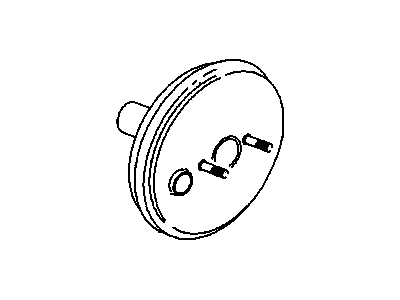
My Garage
My Account
Cart
Genuine Saturn LS Brake Booster
Brake Power Booster- Select Vehicle by Model
- Select Vehicle by VIN
Select Vehicle by Model
orMake
Model
Year
Select Vehicle by VIN
For the most accurate results, select vehicle by your VIN (Vehicle Identification Number).
1 Brake Booster found
Saturn LS Brake Booster
A Brake Booster in Saturn LS automobiles is an essential unit that assists in pulling brake force to the driver. By subjecting it to vacuum chamber environment, hydraulic pressure initiated from the master cylinder is boost; this increase the force exerted on the brake pedal. There are two types of boosters used in LS vehicles: vacuum-operated booster and hydraulic boosters are the two main types of booster systems. The vacuum boosters work on the relative vacuum created by the engines and hydraulic boosters work on a relative fluid pressure for brakes. Mainly, the booster operation can be trusted, however, it can sometimes be faulty and need fixing or changing. Moreover, the performance brake boosters and conversion kits are provided to the clients to enhance their braking system for better performance and reliabilities.
Each OEM Saturn LS Brake Booster we offer is competitively priced and comes with the assurance of the manufacturer's warranty for the part. Furthermore, we guarantee the speedy delivery of your orders right to your doorstep. Our hassle-free return policy is also in place for your peace of mind.
Saturn LS Brake Booster Parts Questions & Experts Answers
- Q: How to check Brake Booster on Saturn LS?A:Brakes should be checked whenever the wheels have been changed or if there are signs of a problem and the signs are pulling to one side, squealing or dragging noises, ability to travel a long distance, pulsating of the pedals or brake fluid leakage. For disc brakes visually inspect in place without having to dismantle by loosening the wheel lug nuts, raising the car safely and removing the wheels in order to get access to the caliper and the pads. Take the outer pad thickness, take the inner pad thickness, replace all the pads if any is lower than the set limit. This is another good indicator, which should be checked for score marks or wear before refitting brake lines and hoses as well as wheels. As for rear drum brakes, check that the parking brake is switched off, tap on a drum before removing them for cleaning. Check the thickness of the lining of the brake shoes and if they are below the limit or if they are damaged get a new one. Check all springs if they're appropriately linked together and look for signs of any loss of lubricant especially in wheel cylinder. Clean the interior of the drum and check for damage and cracks, if any, and refinish the same if required. To do the brake booster check, press the brake while cranking the engine and look if the pedal goes down, check again pedal travel with the engine running and after turning it off. If the pedal is not giving the expected reaction then the brake booster can be defected.




